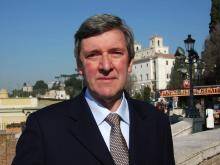On Nov. 8, Pope Francis signed a decree recognizing that Silvio Dissegna, a 12-year-old Italian boy who died from bone cancer on Sept. 24, 1979, had lived the Christian virtues to a heroic degree and can therefore be called venerable.
The signing of that decree may seem an insignificant event in the eyes of the world; but for the pastor-pope, who has given great attention to children and their faith life ever since 1960 in Chile, when he was studying to be a Jesuit, it was an important statement.
By that act he not only opened the door to sainthood for Silvio Dissegna, he also sent a message to the whole church, in the first place to parents, grandparents, bishops, priests, catechists and teachers, that they must give serious attention to the spiritual life of the children in their care and recognize that these “little ones” are indeed close to Jesus and can be great saints even at a tender age.
Francis was impressed by the story of Silvio, who was born in Moncalieri on July 1, 1967, in the Piedmont region of Italy, where the pope’s own family originated. Silvio was a happy boy, full of life, and wanted to be a teacher. When he was 10 years old, his mother bought him a typewriter for Christmas, and he wrote his first page to her: “Thank you mamma for bringing me into the world, for giving me life which is so beautiful! I have a great desire to live.”
His life changed dramatically, however, in early 1978. Not yet 11, he began to feel great pain in his legs. The doctors diagnosed bone cancer and offered no hope of recovery. He began then what would prove to be his Calvary with a rosary in his hand. He held onto that rosary always and often said, “I have many things to say to Jesus and to the Madonna.”
When he received confirmation in May 1978, he was already in a wheelchair. He was soon hospitalized, and there asked the chaplain to bring him holy Communion frequently. He always prayed the rosary and offered his prayers and sufferings for the pope, for missionaries, for the conversion of those far away and that all people may recognize themselves as brothers.
A great crowd attended his funeral, including many priests. Turin’s cardinal-archbishop, Giovanni Saldarini, moved by the stories of the extraordinary faith with which he bore his suffering, opened the cause for his beatification in 1995.
Silvio is but the latest example of children who were very close to Jesus and lived saintly lives that affected many people. Last August, when Pope Francis beatified 124 Korean martyrs in Seoul, one of them was a 12-year-old girl who was martyred with her family. In May 2000, John Paul II beatified two of the children of Fatima, Francisco and Jacinta. They were 9 and 7 years old respectively when they saw the first apparitions, and died at ages 11 and 9. In 1950 Pius XII canonized the Italian virgin-martyr, Maria Goretti, murdered at the age of 11. In fact, there have been many children and teenagers among the martyrs and saints, from the earliest centuries of Christianity to the present day.
As Jesuit superior and, later, as bishop in Buenos Aires, Jorge Mario Bergoglio gave a great deal of attention to children, especially to those living in situations of poverty, suffering or difficulty, and to their faith life. Despite opposition from some senior Vatican officials, he insisted on the right of children to be baptized even if their parents were in irregular marital situations, and he reprimanded priests who refused them baptism. As pope, he has continued to insist on this.
In his homilies at first Communion and confirmation celebrations, he always speaks directly to the children. “If I talk to the children, the parents and adults always listen,” he once said. He listens to them and gets them to pray with him. And he continues to give time and shows great tenderness to children who are sick or suffering.
Though it received little media coverage, the recent Synod of Bishops gave attention to children in a variety of situations worldwide—from ordinary families to broken ones, from single-parent families to those of gay unions, from street children and those exploited in child labor or human trafficking to refugee and migrant children as well as orphans of war—and discussed how to help develop their faith-life in those different circumstances.
This is a big question, sure to be discussed over the next year in dioceses across the globe in preparation for the synod in October 2015. For Francis this is a very important matter that requires reflection and creative response throughout the church.








